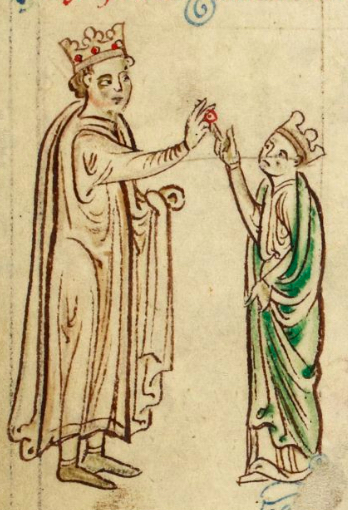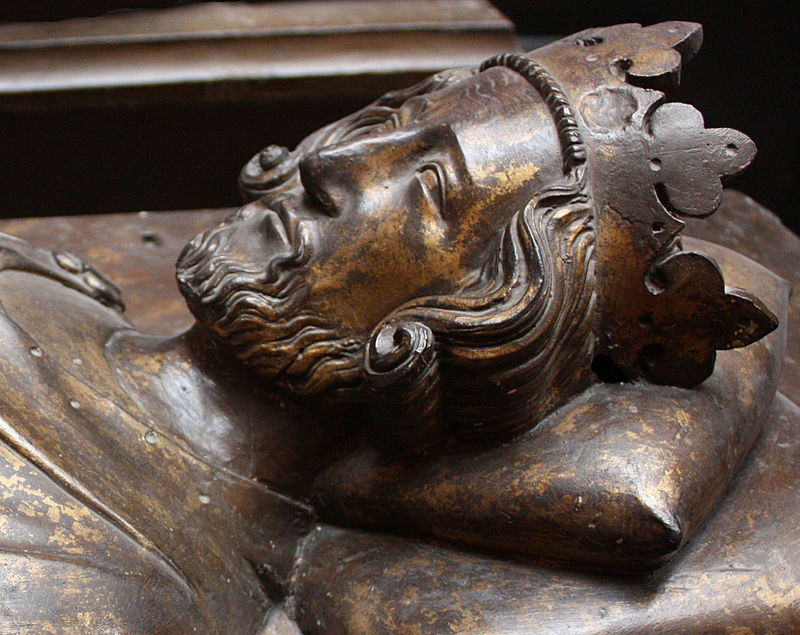by Susan Flantzer © Unofficial Royalty 2015

Credit – Wikipedia
King Henry III became king on October 18, 1216, at the age of nine and reigned 56 years, 29 days, until his death in 1272. Only King George III, Queen Victoria, and Queen Elizabeth II have reigned longer. Henry, born at Winchester Castle on October 1, 1207, was the eldest of the five children of King John and his second wife Isabella, Countess of Angoulême in her own right. Their firstborn child was named after King John’s father, King Henry II. All of Henry’s siblings survived into adulthood, made excellent marriages, and all but Joan had children.
Henry’s siblings:
- Richard, Earl of Cornwall, King of the Romans (1209 – 1272), married (1) Isabel Marshal, had three sons and a daughter, only one son survived childhood, Isabel died in childbirth (2) Sanchia of Provence, had two sons, only one son survived childhood (3) Beatrice of Falkenburg, no children
- Joan of England (1210 – 1238), married Alexander II, King of Scots, no children
- Isabella of England (1214 – 1241), married Friedrich II, Holy Roman Emperor, had at least four children
- Eleanor of England (1215 – 1275), married (1) William Marshal, 2nd Earl of Pembroke, no children (2) Simon de Montfort, 6th Earl of Leicester, had seven children

13th-century depiction of John and children, (l to r) Henry, Richard, Isabella, Eleanor, and Joan; Credit – Wikipedia
King John died on October 18, 1216, leaving Henry, a nine-year-old, to inherit his throne in the midst of the First Barons’ War (1215–17), in which a group of rebellious barons supported by a French army, made war on King John because of his refusal to accept and abide by the Magna Carta. Because a large part of eastern England was under the control of the rebellious barons and the French, it was thought that Henry should be crowned as soon as possible to reinforce his claim to the throne. Therefore, Henry was crowned on October 28, 2016, at Gloucester Cathedral with a golden circlet belonging to his mother as the coronation regalia were at Westminster in London.
William Marshal, 1st Earl of Pembroke, who had served three kings: Henry II, Richard I, and John, was named as the protector of King Henry III, and regent of the kingdom. In spite of being around 70 years of age, Marshal actively participated in the war against the French and the rebel barons with amazing energy. In the Battle of Lincoln, he charged and fought at the head of the young king’s army, leading them to victory. He was preparing to besiege the French in London when the war ended with the naval victories at the Battle of Dover and the Battle of Sandwich. Upon his death in 1219, which greatly affected the young Henry, Marshal was eulogized as “best knight that ever lived” by Stephen Langton, Archbishop of Canterbury.
In July 1217, Henry’s mother Isabella of Angoulême left him in the care of his regent, William Marshal, 1st Earl of Pembroke, and returned to France to assume control of her inheritance of Angoulême, basically abandoning her children by King John. In 1220, she married Hugh X of Lusignan, Count of La Marche with whom she had nine children. Henry’s education was entrusted to Peter de Roches, Bishop of Winchester and Hubert de Burgh, 1st Earl of Kent became regent after the death of William Marshal. On May 20, 1220, Henry was crowned a second time in Westminster Abbey with a full coronation ceremony. Henry was declared of age in 1223 by the pope, but he did not actually reign independently until 1227 when he was 20.

Coronation of King Henry III; Credit – Wikipedia
On January 14, 1236, at Canterbury Cathedral, 29-year-old Henry married 13-year-old Eleanor of Provence, the second of the four daughters of Ramon Berenguer IV, Count of Provence and Beatrice of Savoy. All four daughters married kings and therefore became queens.

Henry III and Eleanor of Provence; Credit – Wikipedia
Henry and Eleanor had five children:
- King Edward I of England (1239 – 1307), married (1) Eleanor of Castile, had issue including his heir Edward II (2) Margaret of France, had issue
- Margaret, Queen of Scots (1240 – 1275), married Alexander III, King of Scots, had issue
- Beatrice, Countess of Richmond (1242 – 1275), married John II, Duke of Brittany, had issue
- Edmund Crouchback, 1st Earl of Lancaster (1245–1296), married (1) Aveline de Forz, no issue (2) Blanche of Artois, had issue
- Katherine of England (1253 – 1257), died in childhood

Henry (top) and his children, (l to r) Edward, Margaret, Beatrice, Edmund, and Katherine; Credit – Wikipedia
Many of Eleanor’s maternal Savoy relatives came to the English court including uncles Pietro and Bonifacio. Pietro lived in England for a long time, served as a diplomat, and became Earl of Richmond. In 1263, he became Count of Savoy. Bonifacio became Archbishop of Canterbury, a position secured by his brother-in-law Henry III. In 1247, Henry’s half-brothers from his mother’s second marriage, the Lusignans came to England and competed for lands and promotions with the queen’s Savoy relatives. Henry’s relatives were rewarded with large estates, largely at the expense of the English barons. From 1236 to 1258, the weak king fluctuated repeatedly between various advisers including his brother Richard of Cornwall and his Lusignan half-brothers, which greatly displeased the English barons. In addition, the English barons were displeased with Henry III’s demands for extra funds, Henry’s methods of government, and widespread famine.
The displeasure of the English nobility with the king ultimately resulted in a civil war, the Second Barons’ War (1264–1267). The leader of the forces against Henry was led by his brother-in-law Simon de Montfort, 6th Earl of Leicester, who was married to Henry’s sister Eleanor. de Montfort wanted to reassert the Magna Carta and force the king to surrender more power to the baron’s council.
In 1264 at the Battle of Lewes, Henry and his son, the future King Edward I, were defeated and captured. Henry was forced to summon a parliament and to promise to rule with the advice of a council of barons. Henry was reduced to a figurehead king, and de Montfort broadened parliamentary representation to include groups beyond the nobility, members from each county of England and many important towns. Fifteen months later, Edward led the royalists into battle again, defeating and killing de Montfort at the Battle of Evesham in 1265. Ultimately, authority was restored to King Henry III and severe retribution was exacted on the rebellious barons. In 1266, a reconciliation between the king and the rebels was worked out with the Dictum of Kenilworth. In the years that followed his death, Simon de Montfort’s grave was frequently visited by pilgrims. Today, de Montfort is considered as one of the fathers of representative government.
Henry was increasingly ill and infirm during his final years. His son and heir Edward became the Steward of England and began to play a more prominent role in government. The most important legacy of King Henry III is Westminster Abbey. In 1042, Edward the Confessor began rebuilding St. Peter’s Abbey to provide himself with a royal burial church, the first Westminster Abbey. Construction of the second and present church was begun in 1245 by Henry III who selected the site for his burial. In 1269, Henry oversaw a grand ceremony to rebury Edward the Confessor in a magnificent new shrine, personally helping to carry the body to its new resting place.
King Henry III died at the age of 69 on November 16, 1272, at the Palace of Westminster in London, England. By his own direction, Henry was buried in the original coffin of Edward the Confessor. Eventually, a grander tomb was built for Henry and on May 10, 1290, his remains were moved to their current location in Westminster Abbey in Edward the Confessor’s Chapel, in a tomb directly north of Edward the Confessor’s shrine.

Effigy of King Henry III; Credit – Wikipedia
This article is the intellectual property of Unofficial Royalty and is NOT TO BE COPIED, EDITED, OR POSTED IN ANY FORM ON ANOTHER WEBSITE under any circumstances. It is permissible to use a link that directs to Unofficial Royalty.
England: House of Plantagenet Resources at Unofficial Royalty
- United Kingdom of Great Britain and Northern Ireland Index
- House of Plantagenet Index (1216 – 1399)
- British Royal Births, Marriages, Deaths, and Other Important Events
- Coronations after the Norman Conquest (1066 – present)
- History and Traditions: Norman and Plantagenet Weddings
- House of Plantagenet Burial Sites

